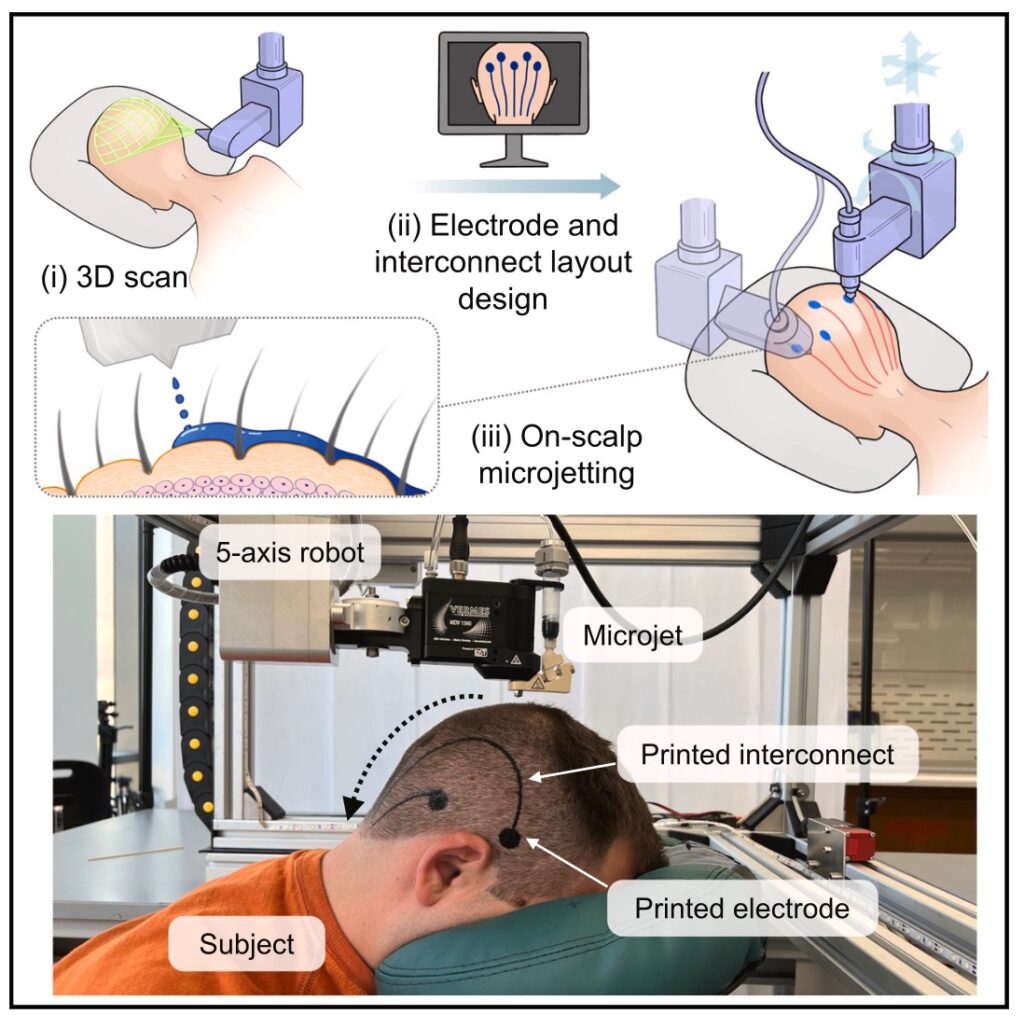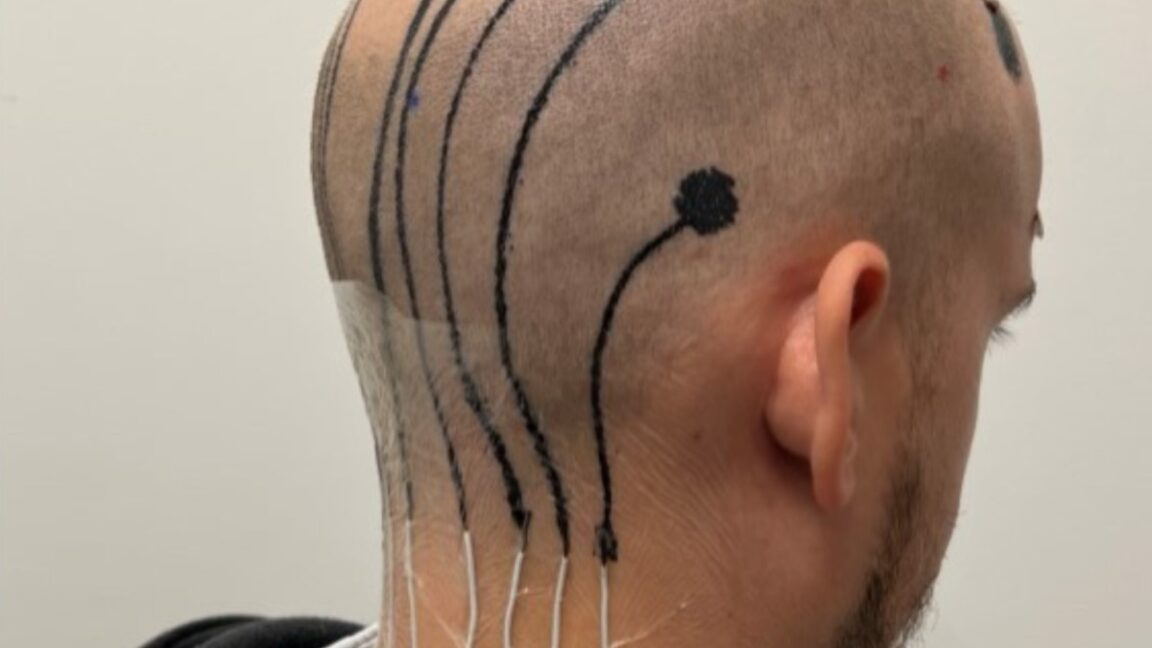Novel polymer-based conductive inks print directly on the scalp surface—even through pesky short hairs.
A 3D-printable EEG electrode e-tattoo. Credit: University of Texas at Austin.
Epidermal electronics attached to the skin via temporary tattoos (e-tattoos) have been around for more than a decade, but they have their limitations, most notably that they don't function well on curved and/or hairy surfaces. Scientists have now developed special conductive inks that can be printed right onto a person's scalp to measure brain waves, even if they have hair. According to a new paper published in the journal Cell Biomaterials, this could one day enable mobile EEG monitoring outside a clinical setting, among other potential applications.
EEGs are a well-established, non-invasive method for recording the electrical activity of the brain, a crucial diagnostic tool for monitoring such conditions as epilepsy, sleep disorders, and brain injuries. It's also an important tool in many aspects of neuroscience research, including the ongoing development of brain-computer interfaces (BCIs). But there are issues. Subjects must wear uncomfortable caps that aren't designed to handle the variation in people's' head shapes, so a clinician must painstakingly map out the electrode positions on a given patient's head—a time-consuming process. And the gel used to apply the electrodes dries out and loses conductivity within a couple of hours, limiting how long one can make recordings.
By contrast, e-tattoos connect to skin without adhesives, are practically unnoticeable, and are typically attached via temporary tattoo, allowing electrical measurements (and other measurements, such as temperature and strain) using ultra-thin polymers with embedded circuit elements. They can measure heartbeats on the chest (ECG), muscle contractions in the leg (EMG), stress levels, and alpha waves through the forehead (EEG), for example.
Ink masters
Yet even e-tattoos have their challenges, such as the aforementioned curved or hairy surfaces, as well as requiring personalized electrode placement design to cover larger areas since biosignals are spatially distributed. So scientists at the University of Texas at Austin and the University of California, Los Angeles, decided to explore the potential of on-tissue printing. Prior work in this area has focused on things like bio-printing hydrogels embedded with cells for tissue regeneration or as strain sensors.

The UTA/UCLA team developed printable biocompatible polymer-based inks that can be applied directly via microjet through short hair onto a lightly moistened scalp. The ink then quickly dries into a soft, stretchable, and conductive, thin film that conforms perfectly to the shape of the scalp. The ink comes in two varieties: one to form electrodes to pick up EEG signals and the other to form highly conductive interconnects that also minimize noise in the readings.
First, a camera is used to map the patient's head, and an algorithm designs the sensor placement to match that and provide instructions to a robotic microjet printer about where to deposit the ink. The printer deposits the ink with sufficient speed to penetrate short hairs on the scalp. There are also short cables that link the printed e-tattoo to a small EEG recorder. Their e-tattoos successfully recorded brain waves from participating subjects.
"This design is ultra-low-profile, mechanically imperceptible to the user," said co-author José del R. Millán of the University of Texas at Austin, a prominent expert in BCIs. "The fact that this device requires less setup and maintenance and the user could eventually wear a hat or a helmet over it means we could achieve longer recording times and learn more about their brain activity.”
This new method still requires a certain time commitment from patients, but it is considerably less time-consuming than a standard EEG, and it's cheaper. Right now, it only works with very short hair, so the group's future efforts will focus on improving the application method for longer, thicker hairs, as well as curly hair. (The latter is often an issue for Black patients requiring EEGs since curly hair can push against the cap and reduce contact between the scalp and the electrodes.) They might try robotic fingers or special combs to separate the hair during printing.
The ink also tends to rub off while the patient is sleeping or showering, so the team will also be looking to increase overall robustness and the ink's resistance to friction. One day, the applications might extend not just to EEGs, ECGs, BCIs, and the like but also make it possible to integrate sensors onto internal organs: the cranium, the heart, or on tissue or bone for regenerative purposes.
"Ultimately, it opens the door for the on-body integration of sensing, processing, communication, and power components tailored specifically to the anatomy and needs of the user," the authors concluded.
DOI: Cell Biomaterials, 2024. 10.1016/j.celbio.2024.100004 (About DOIs).
Hope you enjoyed this news post.
Thank you for appreciating my time and effort posting news every day for many years.
2023: Over 5,800 news posts | 2024 (till end of November): 5,298 news posts
RIP Matrix | Farewell my friend ![]()



3175x175(CURRENT).thumb.jpg.b05acc060982b36f5891ba728e6d953c.jpg)
Recommended Comments
There are no comments to display.
Join the conversation
You can post now and register later. If you have an account, sign in now to post with your account.
Note: Your post will require moderator approval before it will be visible.